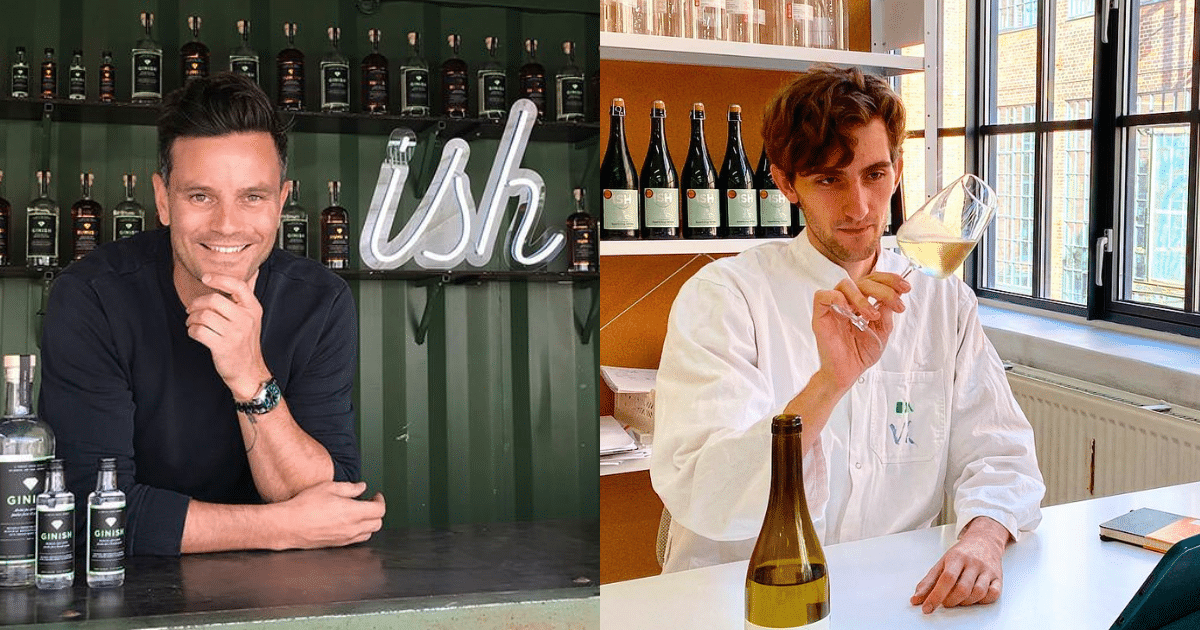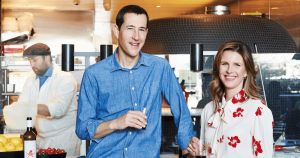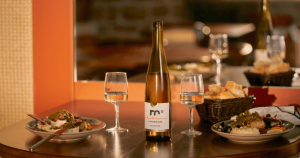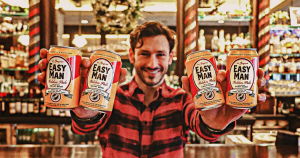For this week’s issue of High Spirits, ISH’s Founder, Morten Sorensen, and its Chief Innovation Officer, Victor Kirketerp, explain how “mindful drinking” drives their brand, plus how they formulate their broad set of alcohol alternatives.
DA: Morten, you started ISH after a 100-day alcohol-free challenge. Can you share more about what inspired this challenge and how it led to the creation of ISH?
Morten: That’s right. I decided to embark on a 100-day alcohol-free challenge back in the fall of 2017. I was honestly tired of alcohol. Literally. I felt slowed down when I consumed alcohol and, with the ambition of wanting to be the best version of myself, it was pretty clear to me that alcohol was limiting that ambition. I’m also the kind of guy that, when things become too much the “norm,” I tend to challenge them and explore how they can be done differently. I’ve done that previously with food, exercise, and travels. Which has taken me to some funny places like Everest Base Camp and rock climbing in Yosemite National Park.
DA: You describe yourself as a “mindful drinker.” How does this philosophy shape the products and mission of ISH?
Morten: The word “mindful” is essential in everything we do at ISH and how I personally live my life. Being mindful is being considerate towards yourself and others. It’s being present and making decisions with a purpose. Mindful drinking, for us, also opens the playing field. It’s not polarizing, judgemental, or excluding. It’s not anti-alcohol but rather more of a welcoming choice. That’s also why we encourage low-alcohol cocktails like a Negroni for example (yes, one of my favorites, too) that rings in at 5% ABV instead of 23%, or a Mindful Margarita with 3% ABV instead of 18%. That’s mindful drinking to us, and our mission is to make it easy to be a mindful drinker and feel free in your choices.
DA: The name “ISH” is quite unique. Can you delve into the story behind the name?
Morten: Thank you. It’s funny, usually in the process of finding the perfect name for your brand you end up in this long, tiring process with pros and cons lists, consumer surveys, and the like. With ISH that was not the case. It simply was always “ISH” in my mind. Even before deciding which drinks to create. The name ISH also reflects the kind of self-ironic personality that the brand embodies, where we don’t take ourselves too seriously.
DA: ISH has won over 40 international taste awards. What do you believe sets your products apart, and how do you maintain this level of quality?
Morten: Although we don’t take ourselves too seriously, we take our products incredibly seriously. Where others might create a product in a matter of weeks, we can easily spend over one year nailing the right composition (which is why Victor, our Chief Innovation Officer, is such an important asset to the development of ISH). Once we launch a product, we immediately start the process of creating the next generation of that same product. Our NA gin and rum, London Botanical and Caribbean Spiced, are now in their third generation. The latest upgrade to Caribbean Spiced was the inclusion of real de-alcoholized rum sourced from the Caribbean.
DA: You emphasize the importance of choice and freedom in drinking. How does ISH cater to various tastes and preferences, ensuring that everyone finds something they love?
Morten: Yes, with our mission of making it easy to be a mindful drinker, we have to cater to a broad palette and ensure we have something for everyone’s liking. We are currently covering wine, spirits, and premixed cocktails. Some like gin, some like wine, some like a Mojito. We cater to that breadth, and we try to excel with every single product and cocktail concoction we introduce so the quality stands out throughout. Peter, our CEO, has coined it “the eyebrow-lifting experience” that spontaneously occurs when people try an ISH product—which is when we know we’ve nailed it.
DA: What do you see as the future of the bar and restaurant space in terms of non-alcoholic offerings? How is ISH preparing for these changes?
Morten: It’s funny, we are seeing many on-premise venues and groups realizing they need to upgrade their NA offerings. A few years back they didn’t take it as seriously as they do now, and that sets up an interesting trajectory for the future where NA simply becomes a must-have within any establishment. Our job is to create amazing products so we can welcome the venues with open arms and help educate them on the category.
DA: Victor, can you share some insights into the research and development process at ISH? How do you approach creating non-alcoholic versions of traditional beverages?
Victor: We monitor the most popular drinks in different categories because we believe that demand for a specific alcoholic drink results in demand for its non-alcoholic counterpart. For me, it is very important to analyze and understand the product we’re trying to replicate—both with my own sensory instrument as well as researching other people’s analyses. Prototyping and collecting feedback is another extremely important step. Doing tastings with beverage professionals and consumers is something we prioritize.
DA: What are some of the unique challenges you face in translating alcoholic variations into their non-alcoholic counterparts? How do you overcome them?
Victor: The ISH product range is quite broad and different categories have different challenges. That said, I find that the main challenges for creating non-alcoholic counterparts to alcoholic products are flavor complexity and mouthfeel.
Flavor complexity is a challenge in my opinion because it’s easy to develop a flavored beverage, but it is much more difficult to develop a beverage that resembles alcohol, sans the alcohol. There’s something about alcoholic beverage occasions that make me stop at that first sip to really analyze and explore every sensory stimuli—and I’m pretty sure I’m not alone in this. I want to make products that take you on a similar journey. Ethanol has the advantage of being a great solvent for flavors, which makes alcoholic beverages very receptive to different treatments, e.g., aging and infusions. To overcome this, I focus on layering flavors and sometimes using seemingly uncharacteristic extracts in our products with the limited solubility that water has. A great example of this is the addition of a sage extract to our Mojito. It gives the drink that little something… that je ne sais quoi, which sets apart the exciting experience from the flat.
Mouthfeel is a second challenge because the ethanol in alcoholic drinks provides several effects. Firstly, it gives the unique “alcohol burn” sensation. This is a chemesthetic sensation resulting from the activation of specific pain, touch, and temperature receptors in the mouth. At ISH, we use a specific chili extract to overcome this challenge. The carbonation in sparkling wines and premixed drinks also help to overcome this challenge. Secondly, ethanol has a slightly higher viscosity (a measure of a liquid resistance to flow; higher viscosity = slower flow), which makes the alcoholic drinks more “full.” The higher the ABV, the more outspoken the difference in fullness, i.e., distilled spirits have more mouthfeel than a beer or low-proof cocktail. To overcome this challenge, we look for other ingredients that increase viscosity. Sugar is a great example of such an ingredient, but it is easily overdone, which I always try to avoid. On top of this there’s the added effects. Increasing the viscosity can limit the overall flavour making it very important to find the right balance.
DA: What innovations are you currently exploring in non-alcoholic beverage formulation? How do you stay ahead of the curve?
Victor: Currently, I’m exploring how to overcome the mouthfeel challenge in other ways than we currently do. I see a lot of non-alcoholic beverages with the flavor of a cocktail, but when I find out that they are actually just flavored without regard to mouthfeel, I get really disappointed.
I keep an eye out for insights from the alcoholic beverage market and stay updated with ingredient suppliers, both big and small. On top of that, we encourage feedback and inspiration from our consumers.
DA: How do you collaborate with Morten to align the research and development process with ISH’s overall mission and philosophy?
Victor: Stakeholder management is very important for all of our projects. I get together weekly and monthly with stakeholders for the different projects to make sure we align on everything from supply chain to sales. This includes Morten as well as many of my other colleagues. This way, we get different perspectives on a project and it is guaranteed that any deviations are thoroughly discussed at these occasions. Fortunately for me, Morten started out by setting clear boundaries for ISH, which makes it so much easier for me as well. It also helps that our marketing department has done a tremendous job of conceptualizing and visualizing the mission of ISH lately.
DA: Can you share any exciting upcoming products that ISH is working on? What can consumers look forward to?
Victor: For the last couple of months, I’ve been heavily invested in still wines. And I believe we’ve taken a great step in the right direction. Many non-alcoholic still wines lack the flavor complexity and mouthfeel of their alcoholic counterparts. This is partly due to the harsh treatment that is de-alcoholization, and it cannot be salvaged by adding sugars and flavors to mimic flavor notes from wines. We’re launching a non-alcoholic white wine, which is unique in that it uses an extract of an actual alcoholic wine to reconstitute the flavors. Furthermore, consumers should really look forward to when we’re done prototyping our non-alcoholic red wine made with above-mentioned technique.
___
Dry Atlas is your guide to the world of alcohol alternatives. We maintain the world’s largest directory of non-alcoholic spirits, wines, beers, and more to help you discover options you’ll love. We also publish High Spirits, the weekly newsletter that helps open-minded drinkers like you learn more about non-alc. Our goal is to demystify alcohol alternatives so you can navigate them with ease to pursue a happier, healthier life.






